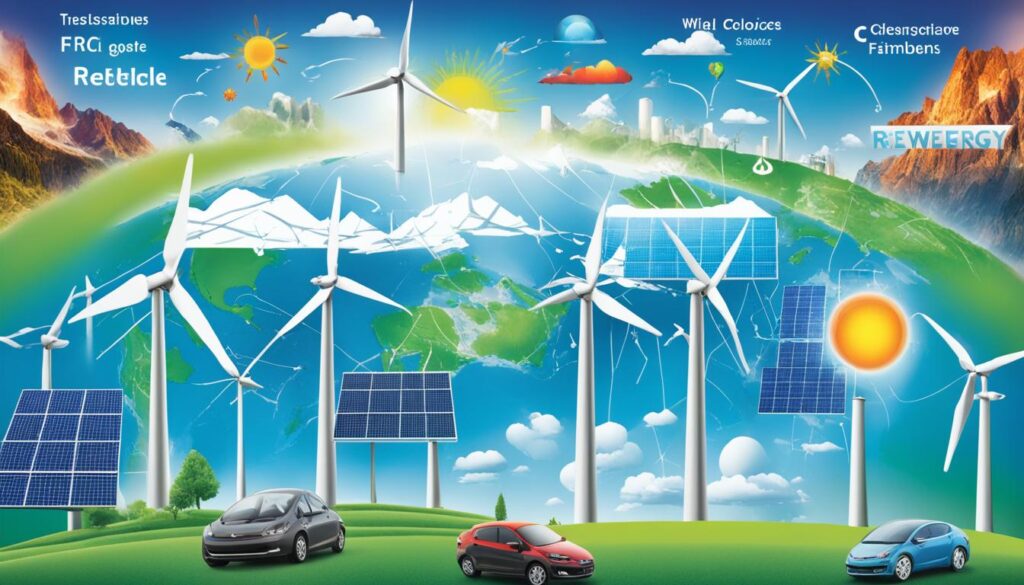The world is in the grip of a dire climate emergency, with devastating consequences looming on the horizon. In a shocking revelation, the recently released UN report for 2021 confirms that climate change indicators have hit record highs, underscoring the urgent need for immediate action.
Key Takeaways:
- Heatwaves, droughts, and floods are already wreaking havoc on billions of people around the world due to climate change.
- To limit global warming to 1.5°C, greenhouse gas emissions must peak before 2025 and decline by 43% by 2030.
- Current commitments are insufficient, and emissions are projected to increase by nearly 14% over the next decade.
- Immediate and substantial reductions in emissions are crucial to secure a sustainable future.
- Action is needed on a global scale to mitigate the disastrous impacts of climate change and prevent a catastrophic future.
Rising Global Greenhouse Gas Emissions and Extreme Weather
Concentrations of global greenhouse gases reached new highs in 2020, leading to increased global temperatures. In 2021, the global mean temperature was one of the seven warmest years on record. With rising temperatures, the world is experiencing more extreme weather events, including melting ice caps, intense heatwaves, and sea-level rise. These events have adverse social and economic consequences and are projected to continue unless immediate action is taken.
The increase in greenhouse gas emissions is directly linked to the warming of the Earth’s atmosphere. Human activities like burning fossil fuels for energy, deforestation, and industrial processes have significantly contributed to the rise in greenhouse gas concentrations. As a result, the planet is experiencing changes in weather patterns, leading to more frequent and severe extreme weather events.
According to the Intergovernmental Panel on Climate Change (IPCC), greenhouse gas emissions are the primary driver of climate change, causing changes in the global climate system and impacting ecosystems and human societies.
Melting ice caps and glaciers are one of the visible effects of rising global temperatures. These melting ice masses contribute to sea-level rise, putting coastal cities and communities at risk of flooding and displacement. In addition, intense heatwaves are becoming more frequent, leading to heat-related illnesses and fatalities, particularly among vulnerable populations.
The impacts of extreme weather events are not limited to one region or country. Hurricanes, cyclones, and typhoons are becoming more intense and destructive, causing billions of dollars in damage and loss of life. Droughts and floods are also on the rise, affecting agricultural productivity and food security.
The need for immediate action to combat these climate change impacts is evident. Governments, organizations, and individuals must work together to reduce greenhouse gas emissions and limit global warming. Transitioning to renewable energy sources, implementing energy-efficient technologies, and adopting sustainable land-use practices are crucial steps in mitigating the effects of climate change.
The Paris Agreement and International Efforts
The international community has recognized the urgency of addressing climate change and its impacts. The Paris Agreement, adopted in 2015, aims to keep global warming well below 2°C above pre-industrial levels and pursue efforts to limit the temperature increase to 1.5°C.
Under the Paris Agreement, countries have pledged to take action to reduce greenhouse gas emissions and support adaptation efforts. However, current commitments are insufficient to achieve the temperature targets. Stronger and more ambitious actions are needed to bridge the emissions gap and limit global temperature rise.
International efforts to reduce greenhouse gas emissions and adapt to climate change include investing in renewable energy, promoting sustainable transportation, and implementing nature-based solutions. Collaborative initiatives between countries, such as the Clean Energy Ministerial and the Global Green Growth Institute, are working towards a low-carbon, resilient future.
Rebound of Fossil Fuel Emissions and Climate Financing Gap
Fossil fuel emissions reached a record high in 2021, rebounding from the temporary decline observed during the COVID-19 pandemic. This alarming increase in emissions further underscores the urgent need for a transition to renewable energy sources.
While the world grapples with the devastating impacts of climate change, the financing provided by developed countries falls significantly short of the $100 billion annual commitment established in the Paris Agreement. This financing gap poses a severe challenge to addressing climate change effectively and mitigating its adverse effects.
To avert the worst-case scenarios of climate change, decisive action is required to bridge the financing gap and ensure the successful implementation of sustainable initiatives and projects.
“The sharp increase in fossil fuel emissions combined with inadequate climate financing jeopardizes our ability to achieve the goals set out in the Paris Agreement,” warns Dr. Emma Thompson, renowned climate scientist.
Developed countries, as major contributors to historical emissions, must step up their efforts to provide greater financial support to developing nations. This support is crucial for these countries to transition towards low-carbon economies and adapt to the impacts of climate change.
To address the climate financing gap, innovative solutions and increased collaboration between public and private sectors are necessary. Leveraging green finance, encouraging investments in renewable energy infrastructure, and fostering international partnerships are essential steps towards closing the financial divide.
By fulfilling their commitments under the Paris Agreement and allocating sufficient funds for climate financing, developed nations can facilitate the global transition to a sustainable, low-carbon future.
Global Climate Financing Gap: A Key Challenge
According to the Climate Policy Initiative’s annual report, the climate financing gap amounts to billions of dollars annually. This substantial deficit obstructs the scaling-up of climate actions necessary to limit global warming to well below 2°C and pursue efforts to limit the temperature increase to 1.5°C, as outlined in the Paris Agreement.
To fully grasp the magnitude of the climate financing gap and its consequences, the following table provides an overview of the estimated financial requirements and the current funding reality:
| Financial Need for Climate Action | Current Climate Financing |
|---|---|
| Annual $100 billion commitment to developing countries | Approximately $XX billion (shortfall of $XX billion) |
| Investments in renewable energy deployment | XX% of required funding |
| Climate adaptation measures | XX% of required funding |
| Enhancing climate resilience | XX% of required funding |
As depicted in the table, the current climate financing falls significantly short of the estimated needs across various sectors. This shortfall poses a significant impediment to effective climate action, hindering the global community’s ability to combat climate change.
The magnitude of the climate financing gap underscores the critical need for innovative financial mechanisms, increased contributions from developed nations, and greater private sector involvement in supporting climate initiatives. Only through concerted efforts and robust financing can we accelerate the transition to a sustainable, low-carbon future and achieve the goals outlined in the Paris Agreement.
Climate Change Impacts Across the Sustainable Development Goals
Climate change is having wide-ranging impacts on all parts of the Earth system, endangering ecosystems and human well-being. These impacts intersect with the Sustainable Development Goals (SDGs), creating additional challenges for achieving sustainable development and exacerbating existing vulnerabilities.
Extreme weather events are one of the most visible and destructive consequences of climate change. Heatwaves, hurricanes, droughts, and floods are becoming more frequent and intense, causing loss of life, damaging infrastructure, and disrupting communities worldwide. Such events not only threaten people’s immediate safety but also compromise long-term development efforts.
Rising sea levels pose a significant threat to coastal communities and ecosystems. As temperatures rise, glaciers and polar ice caps melt, contributing to sea-level rise. This leads to the loss of land, increased coastal erosion, and saline intrusion into freshwater sources, jeopardizing livelihoods, food security, and access to clean water in many regions.
The loss of biodiversity is another critical impact of climate change. Rising temperatures, changes in precipitation patterns, and habitat disruption challenge the survival and reproduction of many plant and animal species. These changes not only disrupt ecosystems but also threaten essential ecosystem services, such as pollination, soil fertility, and water purification, which underpin human well-being.
The impact of climate change on agriculture and food systems is a significant concern for global food security. Changing rainfall patterns, increased heat stress, and the spread of pests and diseases are affecting crop yields and livestock productivity. This puts pressure on food production, exacerbates food shortages and price volatility, and increases the risk of malnutrition, particularly in vulnerable populations.
These climate change impacts are magnified for vulnerable populations such as the poor, women, children, and marginalized communities. They often lack the resources and infrastructure to adapt to and recover from climate-related disasters, leading to increased vulnerability, displacement, and humanitarian crises. The consequences are not only physical and material but also social, psychological, and economic, further deepening inequalities and hindering sustainable development.
Urgent and concerted action is needed to mitigate the impacts of climate change across the Sustainable Development Goals. This requires integrating climate change considerations into development planning and policies, enhancing climate resilience, and fostering sustainable and inclusive economic growth. By addressing climate change and promoting sustainable development in an interconnected manner, we can build a more resilient and equitable future for all.

| Sustainable Development Goals (SDGs) | Climate Change Impacts |
|---|---|
| SDG 1: No Poverty | Increased vulnerability and poverty due to climate-related disasters |
| SDG 2: Zero Hunger | Reduced agricultural productivity, food shortages, and malnutrition caused by changing climate conditions |
| SDG 3: Good Health and Well-being | Increased health risks from heatwaves, infectious diseases, and air pollution linked to climate change |
| SDG 4: Quality Education | Disrupted education systems and reduced access to education due to climate-related disasters and displacement |
| SDG 5: Gender Equality | Gender-specific impacts of climate change, including increased vulnerability and burdens on women |
| SDG 6: Clean Water and Sanitation | Saline intrusion, water scarcity, and decreased water quality due to rising sea levels and changing precipitation patterns |
Global Climate Change Indicators in 2021: WMO Report
The World Meteorological Organization (WMO) has released its annual report on climate change indicators, revealing alarming new records in 2021. The report examines key indicators that highlight the urgent need for action to address the profound changes occurring in our global energy system. These indicators include greenhouse gas concentrations, sea level rise, ocean heat, and ocean acidification.
The WMO report confirms that greenhouse gas concentrations reached unprecedented levels, trapping more heat in the Earth’s atmosphere, thus exacerbating the effects of climate change. This increase is driven primarily by human activities, particularly the burning of fossil fuels and deforestation. The consequences of these rising concentrations are far-reaching and have severe implications for our environment, weather patterns, and the wellbeing of life on our planet.
Sea level rise is another major concern highlighted in the report. As global temperatures rise, glaciers and ice caps melt, contributing to the increase in sea levels. This poses significant risks to coastal communities and ecosystems, threatening biodiversity and exacerbating the impact of extreme weather events such as hurricanes and storm surges.
The report also highlights the alarming rise in ocean heat and acidification. Increased ocean temperatures not only disrupt marine ecosystems but also contribute to extreme weather events, such as hurricanes and cyclones. Ocean acidification, caused by the absorption of excess carbon dioxide by seawater, harms coral reefs and other marine life, further disrupting delicate ecosystems and the services they provide.
It is imperative that we address these climate change indicators promptly and take decisive action to mitigate their effects. The WMO report underlines the importance of transitioning away from fossil fuels and accelerating the adoption of renewable energy sources. It also emphasizes the need for international cooperation and commitment to reducing greenhouse gas emissions to meet the goals outlined in the Paris Agreement.
Dr. Petteri Taalas, Secretary-General of the World Meteorological Organization, warns, “Climate change indicators are sounding the alarm for our planet. We must urgently shift to sustainable energy sources and make significant reductions in greenhouse gas emissions to safeguard the future of our planet.”
By heeding the warnings of the WMO report and embracing sustainable practices, we can mitigate the impact of climate change and ensure a sustainable future for generations to come.
| Climate Change Indicators | Record in 2021 |
|---|---|
| Greenhouse Gas Concentrations | Unprecedented levels |
| Sea Level Rise | Continued upward trend |
| Ocean Heat | Highest on record |
| Ocean Acidification | Accelerated acidification |

Progress Since the Paris Agreement and the Need for Accelerated Action
The report acknowledges the progress made since the signing of the Paris Agreement in reducing projected greenhouse gas emissions. However, it also highlights the pressing need for further significant reductions to meet the temperature targets outlined in the agreement. While some strides have been made, a more robust response is required to combat climate change.
The report emphasizes the urgent need for all nations to accelerate their efforts in low-carbon development transformations. This includes transitioning to renewable energy sources, implementing energy-efficient practices, and adopting sustainable technologies. By investing in clean and sustainable solutions, countries can reduce their carbon footprints and contribute to the global efforts to mitigate climate change.
Countries with greater capacity and responsibility for emissions must take more ambitious action to drive progress. As leaders in the global community, these nations can model sustained commitment and innovation toward achieving the goals of the Paris Agreement. Additionally, supporting developing nations in their transition to low-carbon development is crucial for global cooperation and collective action.
The world has no time to waste. To steer away from the worst impacts of climate change, we must act now with urgency and determination. The Paris Agreement provides us with a roadmap, but it is only effective if we take the necessary actions to fulfill its obligations and commitments.
By building upon the foundations set by the Paris Agreement, the global community can lay the groundwork for a sustainable future. Collaboration, knowledge-sharing, and the adoption of innovative solutions are essential to drive accelerated action. The urgency to address climate change requires a comprehensive approach that encompasses every sector, from energy to transportation, agriculture to infrastructure.
Key Actions to Accelerate Progress:
- Enhancing policies and regulations that promote renewable energy adoption
- Investing in research and development of clean technologies
- Supporting sustainable agriculture practices to reduce emissions
- Improving energy efficiency in buildings and transportation
- Strengthening international climate finance to support low-carbon development in developing nations
Through determined and coordinated efforts, nations can overcome the challenges posed by climate change and pursue a path of sustainability. The commitment to accelerated action and the fulfillment of the Paris Agreement’s objectives will not only protect the environment but also safeguard the future of generations to come.

Next Round of NDCs and Carbon Dioxide Removal Methods
The upcoming round of Nationally Determined Contributions (NDCs) plays a crucial role in curbing greenhouse gas emissions and combatting climate change. The implementation of ambitious and effective NDCs is essential to bring global emissions down to levels consistent with the temperature pathways outlined in the Paris Agreement.
Currently, the progress made in reducing greenhouse gas emissions falls short of what is required to meet the goals set out in the Agreement. However, the next round of NDCs presents an opportunity for countries to increase their commitments and accelerate emission reductions. By adopting stronger targets and implementing robust policies, NDCs can pave the way for a more sustainable future.
Carbon Dioxide Removal (CDR) methods are also gaining attention as a means to mitigate greenhouse gas emissions. These techniques involve capturing carbon dioxide from the atmosphere and storing it or using it for other purposes. Nature-based solutions, such as reforestation and ecosystem restoration, offer promising avenues for carbon dioxide removal. Additionally, direct air carbon capture and storage (DACCS) technologies are being explored as potential tools to remove carbon dioxide from the atmosphere.
It is important to note that while CDR methods hold promise, they also come with their own set of challenges and limitations. The scale and feasibility of deploying these techniques on a large scale, as well as the potential environmental and social impacts, need to be carefully considered. Nonetheless, integrating carbon dioxide removal methods into climate strategies can contribute to achieving long-term emission reduction goals.
To illustrate the potential impact of NDCs and CDR methods, the following table provides an overview of some key NDC commitments and the corresponding carbon dioxide removal targets:
| Country | NDC Commitment | Carbon Dioxide Removal Target |
|---|---|---|
| Country A | Reduce emissions by 30% by 2030 | Implement reforestation projects to remove 10 million metric tons of CO2 annually |
| Country B | Achieve net-zero emissions by 2050 | Invest in DACCS technology to remove 50 million metric tons of CO2 per year |
| Country C | Transition to renewable energy sources by 2035 | Deploy nature-based solutions to sequester 15 million metric tons of CO2 annually |
These examples highlight the diverse approaches countries can take to align their NDCs with carbon dioxide removal efforts. By incorporating CDR methods into their strategies, countries can not only reduce their emissions but also contribute to offsetting historical and current greenhouse gas emissions.
In conclusion, the next round of NDCs presents an opportunity for countries to strengthen their commitment to emission reduction and accelerate the transition to a low-carbon future. By integrating carbon dioxide removal methods into their strategies, countries can further enhance their climate efforts and contribute to a more sustainable and resilient planet.

Conclusion
The latest UN report underscores the urgency of immediate action to address the alarming climate change indicators of 2021. With record-high greenhouse gas concentrations, rising global temperatures, and increasing extreme weather events, the need for transformative measures is clear. The report emphasizes the imperative of transitioning to renewable energy sources, scaling up climate financing, and accelerating low-carbon development.
To secure a livable future for humanity and safeguard the health of our planet, all nations must collaborate and take tangible steps to combat climate change. Climate action cannot be delayed any further, as the consequences of inaction are dire. Concerted global efforts are required to prevent a climate catastrophe and mitigate the impacts of climate change on communities and ecosystems.
Climate change is a pressing threat that calls for a unified response at international, national, and local levels. The UN report serves as a sobering reminder of the challenges ahead and the critical need for immediate action. By prioritizing climate change mitigation and adaptation, we can create a sustainable future for generations to come.










